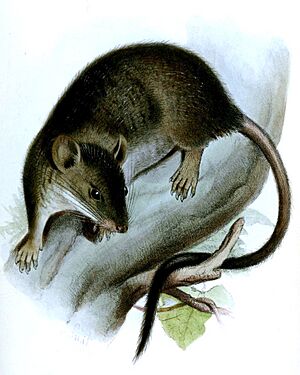White-footed climbing mouse facts for kids
Quick facts for kids White-footed climbing mouse |
|
|---|---|
 |
|
| Conservation status | |
| Scientific classification | |
| Genus: |
Rhipidomys
|
| Species: |
leucodactylus
|
The white-footed climbing mouse (also known by its scientific name, Rhipidomys leucodactylus) is a type of rodent that lives in South America. You can find these mice in countries like Bolivia, Brazil, Ecuador, French Guiana, Guyana, Peru, Suriname, and Venezuela. It's a special kind of mouse because it's the main example for its group of mice (called a genus). It was first discovered on the eastern slopes of the Andes mountains in central Peru.
Contents
About the White-footed Climbing Mouse
The white-footed climbing mouse is the biggest mouse in its group. It can grow to be about 180 millimeters (or 7 inches) long, not counting its tail.
What It Looks Like
Its fur on its back is usually a medium brown color. The hairs have yellowish and reddish bands, with longer, dark hairs mixed in. Its sides are a bit lighter, and its belly is yellowish, cream, or white. The hairs on its belly have gray bases.
The mouse's tail is about the same length as its body. It's covered in short, reddish to dark brown fur and has a long tuft of hair at the end. Its back feet are large. The top part of its feet has a big dark patch that reaches its toes. The sides of its feet and around its toes are a shiny silver color.
Where It Lives
The white-footed climbing mouse lives in the rainforests of the Amazon and Orinoco areas. You can find it in the lowlands of western and central Brazil. It also lives near the Andes mountains in eastern Bolivia and Venezuela. In Peru, it lives up to about 1,750 meters (or 5,740 feet) high. These mice usually live high up in the canopy of trees in wet, evergreen forests.
What It Eats and How It Lives
The white-footed climbing mouse prefers to live in humid, evergreen forests. It mainly eats fruit, which means it is a frugivore. Sometimes, these mice are found near farms, where they might eat crops like pineapple, sugarcane, and yucca. They have also been seen inside people's homes.
Reproduction and Nests
Female mice carrying two or three babies have been seen in Peru during August and September. They have also been observed in Ecuador in September and November. One mouse was found nesting in a hole in a tree, about 15 meters (or 49 feet) off the ground.
Conservation Status
This type of mouse is not very common, but it lives across a very large area. We don't know if its population is growing or shrinking. However, experts believe there are many of these mice in total. Because of this, the International Union for Conservation of Nature says the white-footed climbing mouse is a species of "least concern". This means it is not currently at risk of disappearing.


